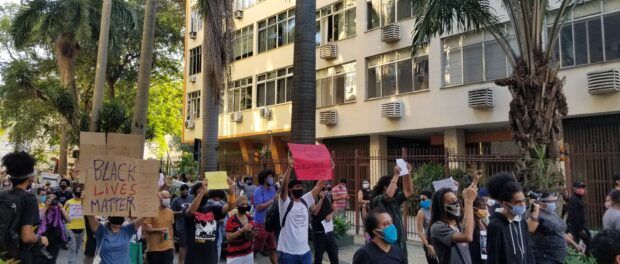A view of the USA from Portugal: ‘Not a riot — rebellion!
The author is a Portuguese left communist and editor of jornalmudardevida.net. This article was translated by WW Managing Editor John Catalinotto.

Hundreds of demonstrators in Brazil gathered outside the office of Rio de Janeiro’s governor on May 31, protesting the deaths of Black and favela youth at the hands of the police. Credit: RioOnWatch
June 5 — This headline [above] appeared over an article published by the U.S. communist weekly Workers World, which is reporting in detail on the protests in the U.S., from coast to coast, in response to the murder of George Floyd by the Minneapolis police [on May 25]. Eleven days after, demonstrations continued across the country, despite brutal threats from Trump and police violence. Over 10,000 people have been arrested.
Solidarity protests have since taken place in various parts of the world. Serious motives have led so many people to come to the streets, facing police and pandemic.
Racism, police brutality, evident in the way Floyd was martyred and lynched in the usual way of white supremacists were the fuse that triggered the protests. But it is undoubtedly the persistent inequalities, the continuous injustices, the decades of state violence that come to the fore in these protests that are the underlying reason for this wave of widespread revolt. The USA is showing the signs of a society in rupture.
The strength of the protests can be seen in two or three points: The demonstrations draw people of all colors and ethnic groups — the most discriminated against and generally the poorest (Black, Latinx), but also many whites who say “no” to injustice, inequality and violence, and especially many young people.
The police forces follow different approaches from city to city. In some cases they use the usual brutality, but in other cases they try to adapt — incorporating themselves into demonstrations or saying “I understand” to the demonstrators, as in Minneapolis. Even if this does not constitute a refusal to comply with orders on the part of grassroots police officers, it is still a sign of caution on the part of commanders.
Finally, there are the disputes at the top, such as the dissension from President Trump by his secretary of defense, who refused to deploy the military to the streets, and the accusation by Gen. Mattis, former secretary of defense, that Trump “divides the country.”
Internationalization of the struggle
What happened in many countries of the world before the health crisis broke has repeated in the U.S. Apparently isolated or unique events triggered waves of massive protests that extended far beyond their immediate causes. Small sparks set uncontrollable fires to huge masses of long-accumulated fuel.
France, Iraq, Algeria, Ecuador, Chile, Tunisia, Sudan — dozens of countries on every continent have been shaken, months on end, by demonstrations that have brought millions of people onto the streets. In many cases, repressive [state] forces caused hundreds of deaths. The hatred — the legitimate hatred of power and of the ruling classes — was expressed in all these cases in the most diverse ways.
The reasons were different in each country, but in all of them one can guess at a common basis: Millions of people feel they are living in a failed world with no future and no present. Acute class conflicts tear apart societies riven by the impoverishment of large popular masses and rampant with corruption and the dizzying enrichment of minorities installed in power. Political institutions are outdated, with false democracies (or none at all) monopolized by hated bourgeois cliques, in which the masses of the people have no voice. This exists on all continents.
Each specific country has its peculiarities, but the common feature of all of them is undeniable: Capitalism, present and dominant throughout the planet, opens up every day bankrupt and [goes] from crisis to crisis. And despite the enormous differences between the so-called developed world and the peripheral world, capitalism drags [all] societies, as diverse as they may be, into chaos.
Those great demonstrations reflect precisely how the masses of people who refuse to be dragged into disaster perceive this chaos. The [protests] are signs of a response — still disconnected and, in many cases, lacking the right path — on the part of the different dispossessed classes in the different countries who feel they have nothing to lose. They may not know where they are going yet, but they are already beginning to say, “No, I’m not going there!”(*)
But if, as someone authoritatively said, the struggle of the proletarians begins as national in form but is international in content — then we are witnessing the progressive internationalization of the anticapitalist struggle.(**)
To have U.S. workers as partners in this struggle is an advance that people around the world can only welcome in the most joyful way.
———
NOTES:
(*)”My life is a whirlwind that’s come loose. /It’s a wave that’s risen. /It’s an atom that has leaped … / I don’t know where I’m going, / I know I’m not going there!”
José Régio,“Cantico Negro”
(**) “Though not in substance, yet in form, the struggle of the proletariat with the bourgeoisie is at first a national struggle. The proletariat of each country must, of course, first of all settle matters with its own bourgeoisie.” K. Marx and F. Engels, “Manifesto of the Communist Party” (Forward Editions), page 47.

